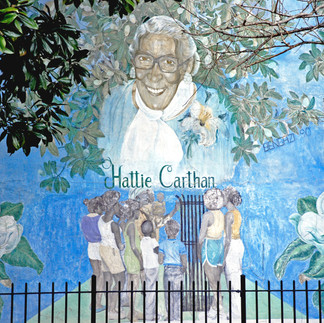
Conservationists of Color Series Contributors (Concept, Research, and Writing): Mary Spindler, Julia Gasink, and Aaron Kershaw

George Washington Carver
Through education and hard work, George Washington Carver became one of the most famous American scientists and inventors of all time. The formerly enslaved man turned agricultural researcher is most known for his work with the peanut, inventing over 300 products with peanuts, including paints, dyes, medicine, and soap. Carver's quest to "help the farthest man down" motivated his research, as he hoped to help poor black farmers with little land reap agricultural success.

Due to his work, Carver gained national respect and notoriety and had the honor to meet with three American presidents, Theodore Roosevelt, Calvin Coolidge, and Franklin Roosevelt, and was the first African American to be honored with a national monument. Additionally, Carver began working for the Tuskegee Institute in 1896, soon establishing the Agricultural Institute at the University.
George Washington Carver laid the foundation for much of our modern environmental beliefs as he saw the importance of humankind preserving the resources that nature provides us.
"Man must take the initiative in using nature to provide sustainable food systems that will help to alleviate hunger, encourage local participation and activism, and to safeguard and control our local food and water systems."

MaVynee "The Beach Lady" Betsch
MaVynee Oshun Betsch was an international opera singer turned environmental activist known for using every resource at her disposal to preserve American Beach, a 40-mile beach in northwest Jacksonville that was once a Jim Crow era vacation attraction for African Americans.
Betsch's motivations to protect American Beach were great, as developers at the time were looking to exploit the historically significant land that served Black beach communities who were barred by law from non-Black beaches. Betsch's great-grandfather, Abraham Lincoln Lewis, was instrumental in founding American Beach in 1935 and cofounding the Afro-American Insurance Company, making him Florida's first Black millionaire. Pride in her great-grandfather's accomplishments and spending much of her childhood on the beach left a positive impression of Betsch, as it did so many others that visited it. Black celebrities, including Duke Ellington, Ray Charles, Joe Louis, and others who would travel from far and wide for a comfortable place to enjoy beach life without discrimination.

Betsch left Florida as a teen to train as an opera singer at Oberlin Conservatory of Music in Ohio, leading to performing throughout Europe and a promising career. As Hurrican Dora leveled much of American Beach in 1964, the civil rights movement removed many of the restrictions that made her family establish the beach in the first place. MaVynee began to feel the beach was calling her home and did just that, doing all she could to conserve it.
In 1975, Betsch moved back to her grandfather's beach house, fighting vigorously to protect American Beach by any means. She donated generously to environmental organizations, eventually allocating her entire inheritance and income to preserve American Beach, ultimately selling her beach house to live on the beach she loved so much and labeling herself "The Beach Lady." After a hard fight to prevent its development, a beautiful dune Betsch named "Na Na" was purchased by a developer but ultimately donated to the National Parks Service in her honor. Betsch died of cancer in 2005, but let us not forget her extraordinary contributions to conservation and her admirable philosophy on life.

"Live simply so that others may simply live."-MaVynee "The Beach Lady" Betsch

Colonel Charles Young
Colonel Charles Young was the first Black National Park Superintendent and colonel in the United States and was the highest-ranking African American officer of his time. Born in 1864 to enslaved parents in May's Lick, Kentucky, Young's parents could only imagine what would be his unprecedented rise to honor and service. Charles ' father escaped enslavement in the same year of his birth, joining the 5th Regiment, U.S. Colored Heavy Artillery by February 1865. Young's parents soon relocated to Ripley, Ohio, the center of abolitionism.

He received a public education, supplemented by his mother, an educated former enslaved woman, a rare occurrence for an enslaved person in that era. Young's love for education led to him becoming an accomplished linguist, speaking Latin, Greek, French, Spanish, and German.
In 1883, Young's father encouraged him to take the entrance examination to the United States Military Academy at West Point, and by 1884 became only the ninth African American to join the academy, and in time, the third to graduate. Young had to persevere through racial insults and social isolation as a cadet.

However, by 1907 Young served in the 9th Cavalry (Buffalo Soldiers) at western posts and rose to the rank of captain, teaching military science, serving as a military attaché, and fighting with distinction in the Philippine-American War and was acknowledged for his professionalism and courage in and out of combat.
Colonel Charles Young is an American hero for his bravery in war and his love for nature. The early U.S. Army was tasked with protecting the national parks, and Young's service made him the first Black National Parks Superintendent at Sequoia National Park. At this post, environmental preservation became the forefront of his life's work, keeping the park free from illegal tree loggers, poachers, and ranchers whose grazing sheep destroyed the parks' natural habitats.
Colonel Charles Young's life is the story of overcoming challenges through education and perseverance and using all he would learn through honorably serving his country on both the battlefield and the park grounds.

Hattie Carthan
Hattie Carthan was a community activist and environmentalist who played an instrumental role in improving Brooklyn, New York. Carthan's early career was as a field interviewer for a market research company. Still, it changed soon after Carthan moved onto the block of Vernon Avenue between Tompkins Ave and Throop Avenue in Bedford-Stuyvesant. This tree-lined block soon deteriorated in the neighborhood over time.
Understanding the importance of tree life in a community, Carthan sent postcards to everyone on her block and formed the T & T Vernon Avenue Block Association, raising funds necessary to purchase and plant trees through block parties.

Carthan's events garnered high attendance and support, including New York City Mayor John Lindsay and the City Parks Department, who provided trees under its tree-matching program.

Carthan soon founded the Bedford-Stuyvesant Beautification Committee in 1966 and was awarded a grant in 1971 to teach children about tree care and provide a stipend for summer work for the Neighborhood Tree Corps. She managed over 100 block associations that planted over 1,500 trees, including ginkgo, sycamore, and honeylocust. During her time in New York City, a lack of shade was amongst the leading causes of death in the summer months, so an urban tree canopy was essential to protect those most at risk.
Carthan was also integral in protecting a thriving 40-foot Magnolia grandiflora tree, raising funds for a protective wall to shield it from construction. The City Landmarks Preservation eventually designated the tree as a living landmark.
Hattie Carthan was a passionate and strong-willed conservationist who deserves recognition and celebration.
"We've already lost too many trees, houses, and people…your community – you owe something to it. I didn't care to run." – Hattie Carthan
Updated on Friday, February 25, 2022.











Comments